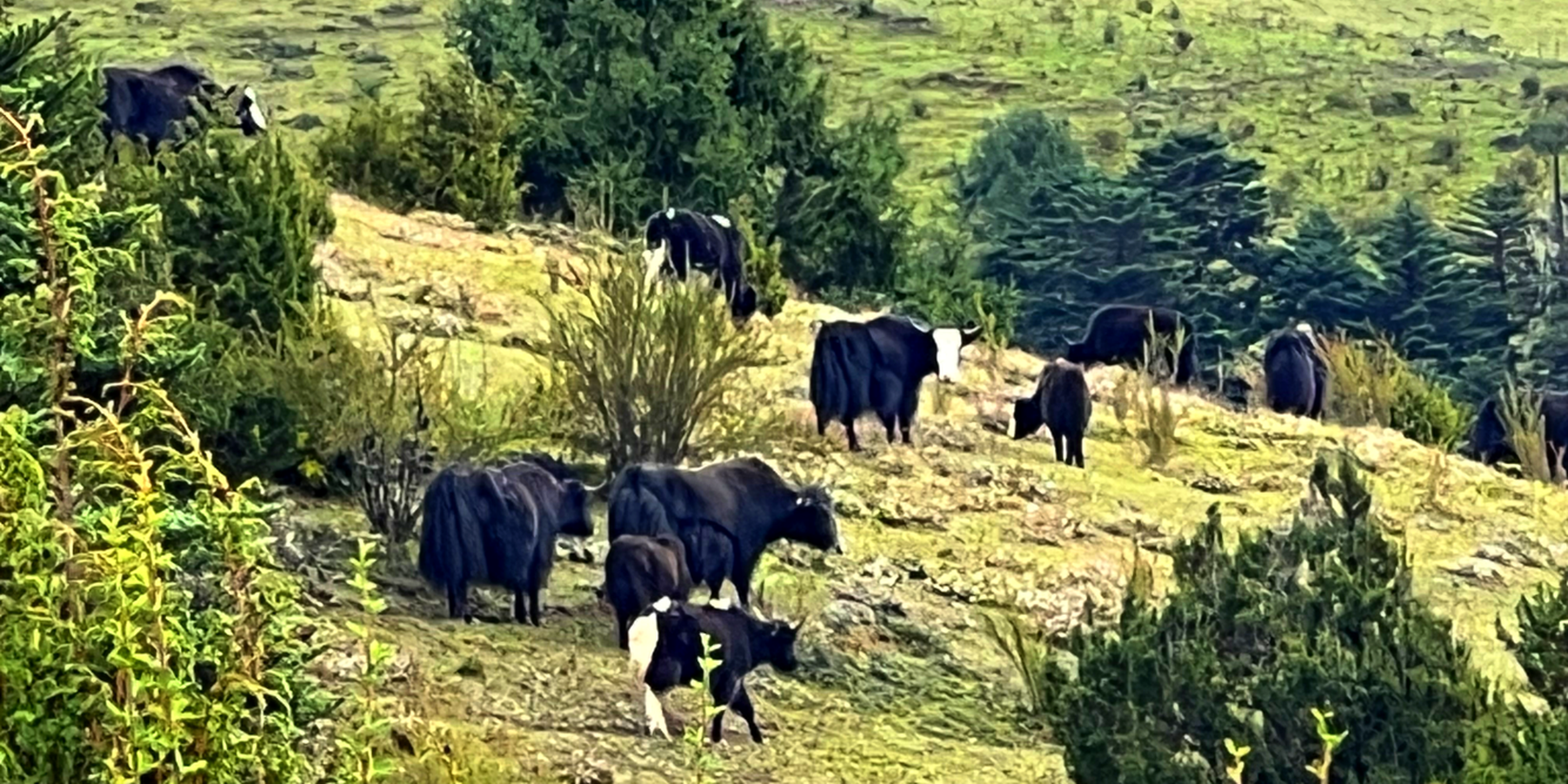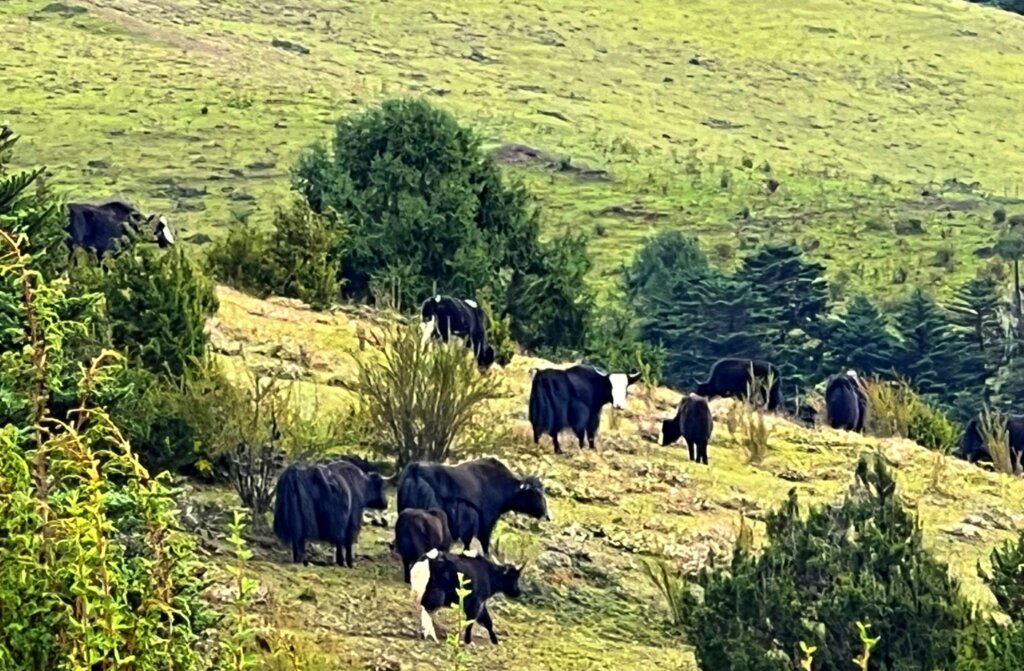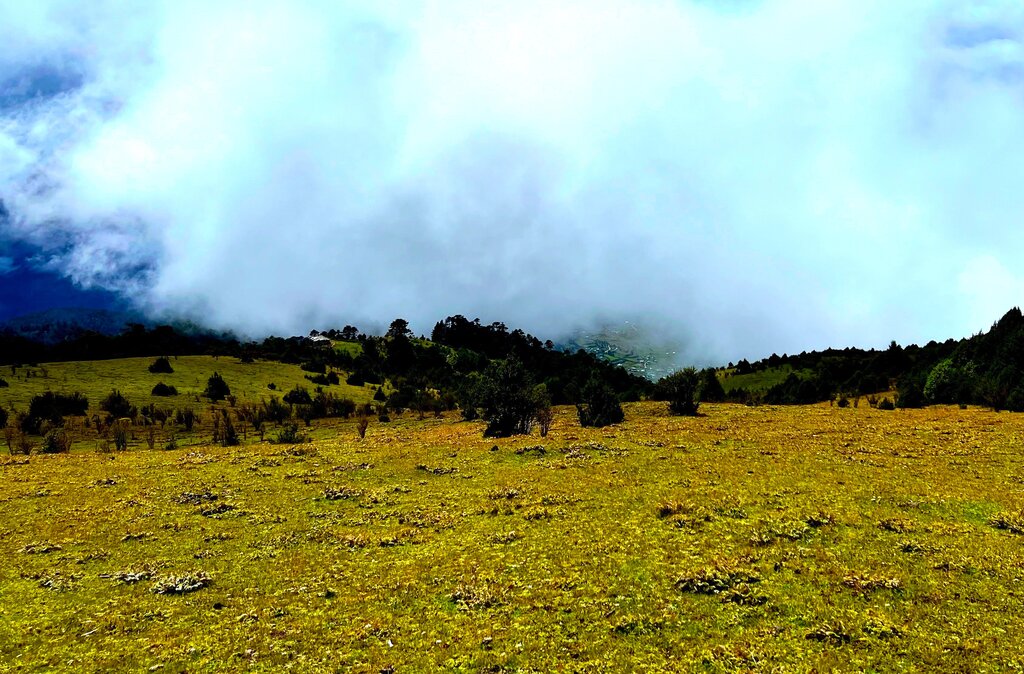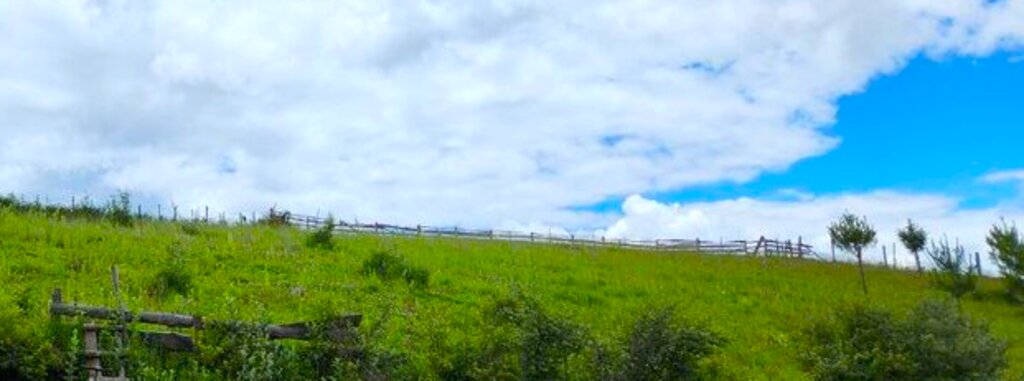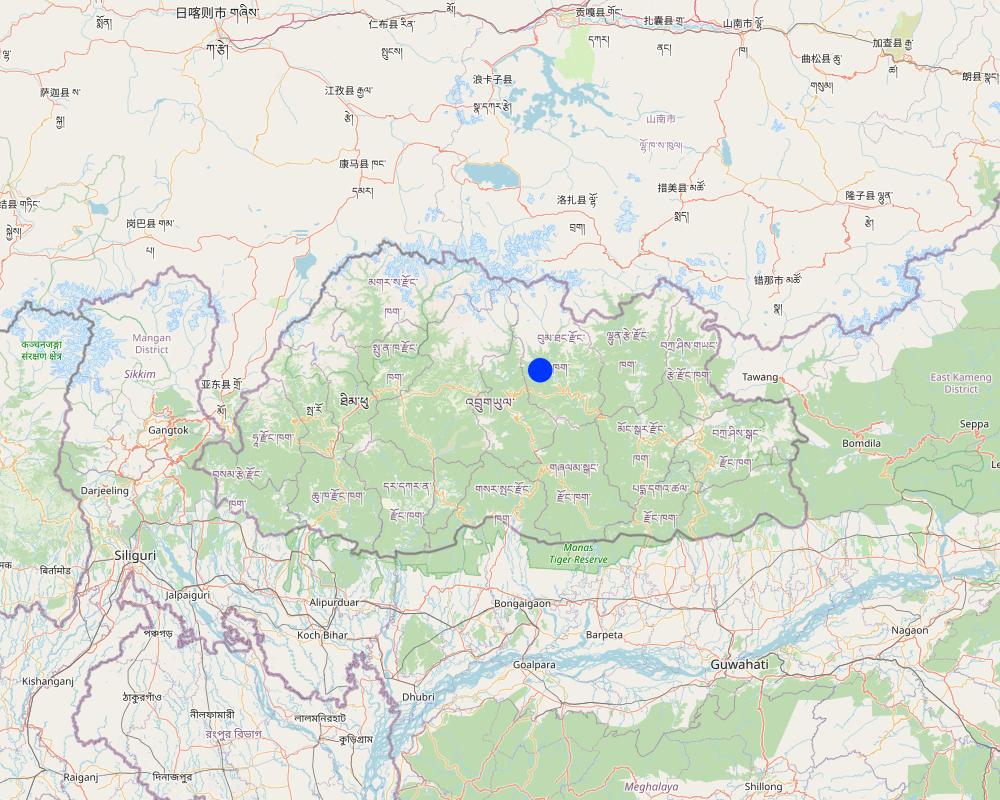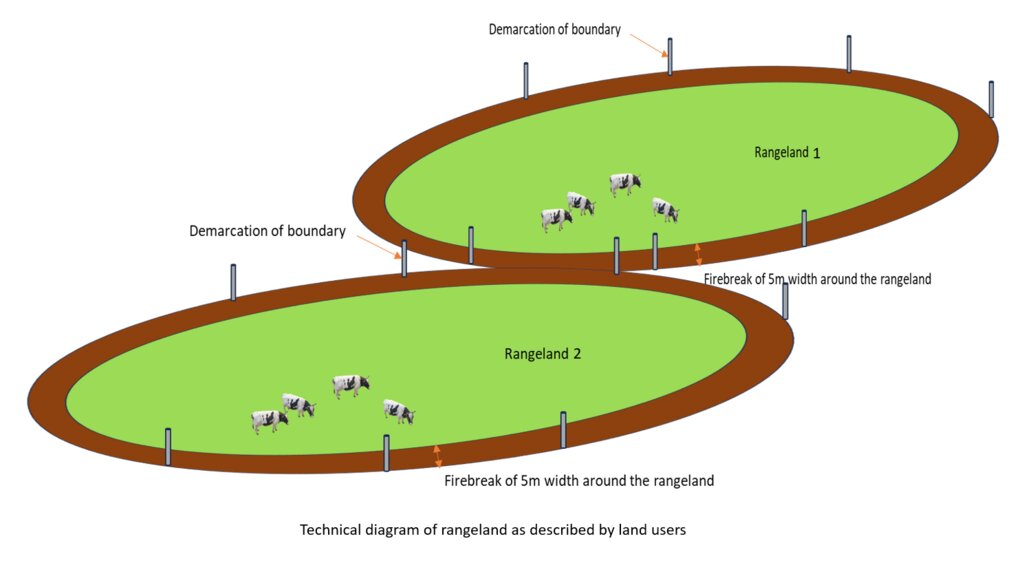Managed Burning of Rangeland [ប្រទេសប៊ូតង់]
- ការបង្កើត៖
- បច្ចុប្បន្នភាព
- អ្នកចងក្រង៖ ONGPO LEPCHA
- អ្នកកែសម្រួល៖ chenga Tshering
- អ្នកត្រួតពិនិត្យច្រើនទៀត៖ William Critchley, Rima Mekdaschi Studer, Joana Eichenberger
Tshaezin Gi Thogley Meytang Tey Tsadrok Zinchong (ཚད་འཛིན་གྱི་ཐོག་ལས་མེ་བཏང་སྟེ་ཙྭ་འབྲོག་འཛིན་སྐྱོང་།)
technologies_6855 - ប្រទេសប៊ូតង់
ពិនិត្យមើលគ្រប់ផ្នែក
ពង្រីកមើលទាំងអស់ បង្រួមទាំងអស់1. ព័ត៌មានទូទៅ
1.2 ព័ត៌មានលម្អិតពីបុគ្គលសំខាន់ៗ និងស្ថាប័នដែលចូលរួមក្នុងការវាយតម្លៃ និងចងក្រងឯកសារនៃបច្ចេកទេស
បុគ្គលសំខាន់ម្នាក់ (ច្រើននាក់)
អ្នកប្រើប្រាស់ដី:
Phurba
Dhur community
ប្រទេសប៊ូតង់
អ្នកប្រើប្រាស់ដី:
Phuntsho Kelzang
Dhur community
ប្រទេសប៊ូតង់
ឈ្មោះគម្រោងដែលបានចងក្រងឯកសារ/ វាយតម្លៃលើបច្ចេកទេស (បើទាក់ទង)
Strengthening national-level institutional and professional capacities of country Parties towards enhanced UNCCD monitoring and reporting – GEF 7 EA Umbrella II (GEF 7 UNCCD Enabling Activities_Umbrella II)ឈ្មោះអង្គភាពមួយ (ច្រើន) ដែលបានចងក្រងឯកសារ/ វាយតម្លៃបច្ចេកទេស (បើទាក់ទង)
National Soil Services Centre, Department of Agriculture, Ministry of Agriculture & Livestock (NSSC) - ប្រទេសប៊ូតង់1.3 លក្ខខណ្ឌទាក់ទងទៅនឹងការប្រើប្រាស់ទិន្នន័យដែលបានចងក្រងតាមរយៈ វ៉ូខេត
អ្នកចងក្រង និង(បុគ្គលសំខាន់ៗ)យល់ព្រមទទួលយកនូវលក្ខខណ្ឌនានាទាក់ទងទៅនឹងការប្រើប្រាស់ទិន្នន័យដែលបានចងក្រងតាមរយៈវ៉ូខេត:
បាទ/ចា៎
1.4 សេចក្តីប្រកាសស្តីពីចីរភាពនៃការពណ៌នាពីបច្ចេកទេស
តើបច្ចេកទេសដែលបានពណ៌នានេះមានបញ្ហាដែលផ្តោតលើការធ្លាក់ចុះគុណភាពដី, បើដូច្នេះវាមិនអាចត្រូវបានប្រកាសថាជាបច្ចេកទេសនៃការគ្រប់គ្រងប្រកបដោយចីរភាពទេ?
ទេ
មតិយោបល់:
While this practice may be criticised on the basis of reducing biodiversity and leading to some GHG losses, it is an important land management practice that has certain specific benefits including making the land more productive.
2. ការពណ៌នាពីបច្ចេកទេស SLM
2.1 ការពណ៌នាដោយសង្ខេបពីបច្ចេកទេស
និយមន័យបច្ចេកទេស:
Burning of rangeland (“tsamdro”) is a traditional management practice adopted by highlanders to control unpalatable grass and shrub species. This helps them produce adequate fodder for their yaks, cattle, horses, and sheep by creating a favorable environment for palatable grasses.
2.2 ការពណ៌នាលម្អិតពីបច្ចេកទេស
ការពណ៌នា:
The practice of burning rangeland (“tsamdro”) is a longstanding tradition among highlanders, whose livelihoods depend on livestock including yaks, cattle, horses and sheep. It is mainly practiced by transhumant communities or individuals who rely on livestock for their livelihoods. They follow a migratory livestock husbandry system that takes them from the highlands to the lowlands dependent on the availability of fodder resources, while simultaneously avoiding the extremes of climate. In the past, rangeland was allocated to individuals, communities, or religious bodies through payment for a minimal annual grazing permit, granting grazing rights. When pasture was scarce, controlled fires were intentionally set in specific areas to rejuvenate the rangeland with fresh grass and control unpalatable grasses and shrubs. For instance, the transhumant nomadic communities of Dhur village, Choekhor Gewog, in Bumthang have adopted the practice of burning rangeland. This practice is implemented during the winter months, dependent on weather, vegetation status, and wind patterns. Rooted in traditional knowledge and cultural practices, the practice is slowly diminishing nowadays due to environmental concerns and labour shortages as young nomads migrate - seeking better employment in towns.
The technique serves multiple purposes. These include promoting the growth of fresh and palatable pasture rich in protein, increasing plant diversity, adding nutrients to the soil through ash, and reducing dead plant material that inhibits new plant growth. Additionally, rangeland burning contributes to the control of livestock pests, especially ticks and flies. While rangeland burning is a straightforward process, it requires careful planning of time and location, creation of fire breaks to prevent uncontrollable spread, and leaving the land fallow for 2 to 3 years after burning to encourage grass growth.
Land users appreciate the technology for reducing their workload in collecting wild fodder grasses, enhancing visibility by removing trees and shrubs, and reducing the risk of predators. However, risks include the potential for uncontrolled fires if not properly managed and harm to the ecosystem and biodiversity in and around the pastureland. Burning also contributes to the loss of carbon dioxide (a greenhouse gas) to the atmosphere.
2.3 រូបភាពនៃបច្ចេកទេស
2.5 ប្រទេស/តំបន់/ទីតាំងកន្លែង ដែលបច្ចេកទេសត្រូវបានអនុវត្ត និងបានគ្រប់ដណ្តប់ដោយការវាយតម្លៃនេះ
ប្រទេស:
ប្រទេសប៊ូតង់
តំបន់/រដ្ឋ/ខេត្ត:
Bumthang Dzongkhag (District)
បញ្ជាក់បន្ថែមពីលក្ខណៈនៃទីតាំង:
Dhur village, Choekhor Gewog (Block)
បញ្ជាក់ពីការសាយភាយនៃបច្ចេកទេស:
- ត្រូវបានផ្សព្វផ្សាយត្រឹមតំបន់មួយ
ប្រសិនបើមិនច្បាស់ពីទំហំផ្ទៃដី សូមធ្វើការប៉ាន់ប្រម៉ាណ:
- 0.1-1 គម2
តើបច្ចេកទេស (មួយ ឬច្រើន) ទាំងនោះស្ថិតនៅក្នុងតំបន់ការពារជាអចិន្ត្រៃយ៍ណាមួយដែរឬទេ?
ទេ
មតិយោបល់:
The total area of rangeland owned was 70 acres (from the two individual who the enumerators interviewed)
Map
×2.6 កាលបរិច្ឆេទនៃការអនុវត្ត
ប្រសិនបើមិនច្បាស់ឆ្នាំ សូមបញ្ជាក់កាលបរិច្ឆេទដែលប្រហាក់ប្រហែល:
- ច្រើនជាង 50 ឆ្នាំមុន (ប្រពៃណី)
2.7 ការណែនាំពីបច្ចេកទេស
សូមបញ្ជាក់តើបច្ចេកទេសត្រូវបានណែនាំឱ្យអនុវត្តដោយរបៀបណា:
- ជាផ្នែកនៃប្រព័ន្ធប្រពៃណី (> 50 ឆ្នាំ)
មតិយោបល់ (ប្រភេទនៃគម្រោង ។ល។):
Traditional practice of burning rangeland was adopted by the transhumant nomadic community of Dhur village called the Bjobs since time immemorial.
3. ចំណាត់ថ្នាក់នៃបច្ចេកទេស SLM
3.1 គោលបំណងចម្បង (១ ឬច្រើន) នៃបច្ចេកទេសនេះ
- ធ្វើឱ្យប្រសើរឡើងនូវផលិតកម្ម
3.2 ប្រភេទដីប្រើប្រាស់មួយប្រភេទ (ច្រើនប្រភេទ) ដែលបានអនុវត្តបច្ចេកទេស
ដីប្រើប្រាស់ចម្រុះនៅលើដីតែមួយ:
បាទ/ចា៎
បញ្ជាក់ពីប្រភេទដីច្រើនប្រភេទ (ដីដាំដំណាំ/ដីចិញ្ចឹមសត្វ/ដីព្រៃឈើ):
- ដីព្រៃឈើ និងដីចិញ្ចឹមសត្វ

ដីសម្រាប់ចិញ្ចឹមសត្វ
វាលស្មៅធំៗ:
- ពនេចរ
- Pasture grass is natural grown and livestock are allowed to graze on it
- Yak
តើជាការអនុវត្តការគ្រប់គ្រងដែលរួមបញ្ចូលការដាំដំណាំ និងចិញ្ចឹមសត្វដែរឬទេ?
ទេ
ផលិតផល និងសេវាកម្ម:
- សាច់
- ទឹកដោះគោ
- ស្បែក
ប្រភេទពូជ:
សត្វពាហនៈ - សត្វចិញ្ចឹមយកទឹកដោះ
ចំនួន:
50
ប្រភេទពូជ:
សត្វពាហនៈ - សត្វចិញ្ចឹមយកទឹកដោះ
ចំនួន:
55

ដីព្រៃ/ដីដាំដើមឈើ
- ព្រៃ (ពាក់កណ្តាល) ធម្មជាតិ/ ដីព្រៃ
ព្រៃ (ពាក់កណ្តាល) ធម្មជាតិ / ដីព្រៃ៖ បញ្ជាក់ប្រភេទនៃការគ្រប់គ្រង:
- ឈើងាប់ៗ/ មែកដែលបាក់
ប្រភេទព្រៃ (ពាក់កណ្តាល) ធម្មជាតិ:
- សារពើរុក្ខជាតិនៅប្រព័ន្ធភ្នំធម្មជាតិ temperate
- Pine, Chirpine, Fir and Cypress
តើប្រភេទឈើខាងលើជាប្រភេទឈើក្នុងព្រៃល្បោះ ឬស្រោង?
- ព្រៃស្រោង
ផលិតផល និងសេវាកម្ម:
- ការអភិរក្ស/ការការពារធម្មជាតិ
3.3 បន្ទាប់ពីអនុវត្តបច្ចេកទេស តើដីប្រើប្រាស់មានការប្រែប្រួលដែររឺទេ?
បន្ទាប់ពីអនុវត្តបច្ចេកទេស តើដីប្រើប្រាស់មានការប្រែប្រួលដែររឺទេ?
- ទេ (បន្តទៅសំណួរ 3.4)
3.4 ការផ្គត់ផ្គង់ទឹក
ការផ្គត់ផ្គង់ទឹកនៅកន្លែងអនុវត្តបច្ចេកទេស:
- ទឹកភ្លៀង
មតិយោបល់:
There are water sources in their summer pasture lands; however, for the growth of the pasture grass, water supply is mostly dependent on rain.
3.5 ក្រុម SLM ដែលបច្ចេកទេសស្ថិតនៅក្នុង
- កសិរុក្ខកម្ម (pastoralism) និងការគ្រប់គ្រងដីសម្រាប់ចិញ្ចឹមសត្វ
3.6 វិធានការ SLM ដែលបញ្ចូលនូវបច្ចេកទេស

វិធានការគ្រប់គ្រង
- M5: គ្រប់គ្រង/ ការប្លាស់ប្តូរសមាសភាពពូជ
មតិយោបល់:
The main SLM measure includes the burning of rangeland to regenerate palatable grass species. In the process of burning invasive species are killed, and the desired clearing of weeds is achieved finally resulting in an environment with fresh grasses for livestock.
3.7 កំណត់ប្រភេទនៃការធ្លាក់ចុះគុណភាពដីសំខាន់ៗដែលបច្ចេកទេសនេះបានដោះស្រាយ

ផ្សេងៗ
សូមបញ្ជាក់:
Revitalise and regenerate growth of palatable grass species to be used for livestock grazing
មតិយោបល់:
This technology do not address land degradation issue .
3.8 ការពារ កាត់បន្ថយ ឬស្តារឡើងវិញនៃការធ្លាក់ចុះគុណភាពដី
បញ្ជាក់ពីគោលដៅរបស់បច្ចេកទេស ដែលផ្តោតទៅការធ្លាក់ចុះគុណភាពដី:
- ដែលមិនអាចអនុវត្តបាន
មតិយោបល់:
It is used to regenerate and revitalise growth of palatable grass species.
4. បច្ចេកទេសជាក់លាក់ សកម្មភាពអនុវត្ត ធាតុចូល និងថ្លៃដើម
4.1 គំនូសបច្ចេកទេសនៃបច្ចេកទេសនេះ
លក្ខណៈពិសេសនៃបច្ចេកទេស (ទាក់ទងនឺងគំនូរបច្ចេកទេស):
Firebreak of 5 m are kept to control the burning
ឈ្មោះអ្នកនិពន្ធ:
Ongpo Lepcha
កាលបរិច្ឆេទ:
16/02/2024
4.2 ព័ត៌មានទូទៅដែលពាក់ព័ន្ធនឹងការគណនាធាតុចូល និងថ្លៃដើម
កំណត់របៀបនៃការគណនាថ្លៃដើម និងធាតុចូល:
- ក្នុងតំបន់អនុវត្តបច្ចេកទេស
កំណត់ទំហំ និងឯកត្តាផ្ទៃដី:
1 acres
បើសិនប្រើឯកតាតាមតំបន់ សូមបញ្ជាក់តម្លៃបម្លែងវាទៅជាហិកតា (ឧ. 1 ហិកតា = 2.47 អា)៖ 1 ហិកតា =:
0.4 hectare
ផ្សេងៗ/ រូបិយប័ណ្ណជាតិ (បញ្ជាក់):
Bhutanese Ngultrum
បើពាក់ព័ន្ធសូមកំណត់អត្រាប្តូរប្រាក់ពីដុល្លាទៅរូបិយប័ណ្ណតំបន់ (ឧ. 1 ដុល្លារ = 79.9 រៀលនៃរូបិយប័ណ្ណប្រេស៊ីល) ៖ 1 ដុល្លារ =:
82,08
កំណត់ថ្លៃឈ្នួលជាមធ្យមនៃការជួលកម្លាំងពលកម្មក្នុងមួយថ្ងៃ:
1200
4.3 សកម្មភាពបង្កើត
| សកម្មភាព | រយៈពេល (រដូវកាល) | |
|---|---|---|
| 1. | Creating fire break around the pasture land | During the winter season |
| 2. | Burning of the pasture land | During the winter season |
| 3. | After burning the land is left fallow for the pasture land to establish | Kept fallow for the next 2 to 3 years |
4.4 ថ្លៃដើម និងធាតុចូលដែលត្រូវការសម្រាប់ការបង្កើតបច្ចេកទេស
| បញ្ជាក់ពីធាតុចូល | ឯកតា | បរិមាណ | ថ្លៃដើមក្នុងមួយឯកតា | ថ្លៃធាតុចូលសរុប | % នៃថ្លៃដើមដែលចំណាយដោយអ្នកប្រើប្រាស់ដី | |
|---|---|---|---|---|---|---|
| កម្លាំងពលកម្ម | Labours | person-days | 9,0 | 1200,0 | 10800,0 | 98,0 |
| សម្ភារៈ | grass cutter | No | 1,0 | 15000,0 | 15000,0 | |
| សម្ភារៈ | Pipe | Bundle | 1,0 | 3000,0 | 3000,0 | |
| សម្ភារៈ | Spade | No | 3,0 | 500,0 | 1500,0 | |
| ថ្លៃដើមសរុបក្នុងការបង្កើតបច្ចេកទេស | 30300,0 | |||||
| ថ្លៃដើមសរុបក្នុងការបង្កើតបច្ចេកទេសគិតជាដុល្លារ | 369,15 | |||||
មតិយោបល់:
The cost for the pasture burning is very minimal and even the labours normally are from their own household.
4.5 សកម្មភាពថែទាំ
| សកម្មភាព | ពេលវេលា/ ភាពញឹកញាប់ | |
|---|---|---|
| 1. | Land is left fallow | For 2 to 3 years |
មតិយោបល់:
The rangeland after burning is left fallow for the next 2 to 3 years. During that time, the land user would graze their yaks in other pasture land.
4.6 កំណត់ថ្លៃដើមសម្រាប់ការថែទាំ/ សកម្មភាពរបស់បច្ចេកទេស (ក្នុងរយៈពេលមួយឆ្នាំ)
មតិយោបល់:
Expenditure not incurred for the maintenance of the technology.
4.7 កត្តាសំខាន់បំផុតដែលមានឥទ្ធិពលដល់ការចំណាយ
ពណ៌នាពីកត្តាប៉ះពាល់ចម្បងៗទៅលើថ្លៃដើម:
Labour cost
5. លក្ខណៈបរិស្ថានធម្មជាតិ និងមនុស្ស
5.1 អាកាសធាតុ
បរិមាណទឹកភ្លៀងប្រចាំឆ្នាំ
- < 250 មម
- 251-500 មម
- 501-750 មម
- 751-1,000 មម
- 1,001-1,500 មម
- 1,501-2,000 មម
- 2,001-3,000 មម
- 3,001-4,000 មម
- > 4,000 មម
លក្ខណៈពិសេស/ មតិយោបល់លើរដូវភ្លៀង:
The data was used from the National Center for Hydrology and Meteorology from the nearest weather station.
បញ្ជាក់ឈ្មោះឯកសារយោងនៃស្ថានីយឧតុនិយម:
https://www.nchm.gov.bt/home/pageMenu/906
តំបន់កសិអាកាសធាតុ
- មានភ្លៀងតិចតួច
Cool temperate zone
5.2 សណ្ឋានដី
ជម្រាលជាមធ្យម:
- រាបស្មើ (0-2%)
- ជម្រាលតិចតួច (3-5%)
- មធ្យម (6-10%)
- ជម្រាលខ្ពស់បន្តិច (11-15%)
- ទីទួល (16-30%)
- ទីទួលចោត (31-60%)
- ទីទួលចោតខ្លាំង (>60%)
ទម្រង់ដី:
- ខ្ពង់រាប
- កំពូលភ្នំ
- ជម្រាលភ្នំ
- ជម្រាលទួល
- ជម្រាលជើងភ្នំ
- បាតជ្រលងភ្នំ
តំបន់តាមរយៈកម្ពស់ :
- 0-100 ម
- 101-500 ម
- 501-1,000 ម
- 1,001-1,500 ម
- 1,501-2,000 ម
- 2,001-2,500 ម
- 2,501-3,000 ម
- 3,001-4,000 ម
- > 4,000 ម
បញ្ជាក់ថាតើបច្ចេកទេសនេះត្រូវបានអនុវត្តន៍នៅក្នុង:
- មិនពាក់ព័ន្ធទាំងអស់
5.3 ដី
ជម្រៅដីជាមធ្យម:
- រាក់ខ្លាំង (0-20 សម)
- រាក់ (21-50 សម)
- មធ្យម (51-80 សម)
- ជ្រៅ (81-120 សម)
- ជ្រៅខ្លាំង (> 120 សម)
វាយនភាពដី (ស្រទាប់លើ):
- មធ្យម (ល្បាយ, ល្បាប់)
សារធាតុសរីរាង្គនៅស្រទាប់ដីខាងលើ:
- ខ្ពស់ (>3%)
5.4 ទឹកដែលអាចទាញមកប្រើប្រាស់បាន និងគុណភាពទឹក
ទឹកលើដីដែលអាចទាញយកប្រើប្រាស់បាន:
ល្អ
គុណភាពទឹក (មិនបានធ្វើប្រត្តិកម្ម):
ទឹកពិសារដែលមានគុណភាពល្អ
គុណភាពទឹក គឺផ្តោតទៅលើ៖:
ទឹកលើផ្ទៃដី
តើមានបញ្ហាភាពទឹកប្រៃហូរចូលមកដែរឬទេ?
ទេ
តើទឹកជំនន់កំពុងកើតមាននៅតំបន់នេះដែររឺទេ?
ទេ
5.5 ជីវៈចម្រុះ
ភាពសម្បូរបែបនៃប្រភេទ:
- ទាប
ភាពសម្បូរបែបនៃទីជម្រក:
- ទាប
មតិយោបល់ និងលក្ខណៈពិសេសផ្សេងទៀតលើជីវចម្រុះ:
Since, only grasses are grown in the land, the species and habitat diversity is very low. Other factors that determine low diversity could be due to low temperature.
5.6 លក្ខណៈនៃអ្នកប្រើប្រាស់ដីដែលអនុវត្តបច្ចេកទេស
នៅមួយកន្លែង ឬពនេចរ :
- ពនេចរ
ទីផ្សារនៃប្រព័ន្ធផលិតកម្ម:
- ពាក់កណ្តាលពាណិជ្ជកម្ម (ផ្គត់ផ្គង់ខ្លួនឯង/ ពាណិជ្ជកម្ម)
ចំណូលក្រៅកសិកម្ម:
- ច្រើនជាង 50% នៃចំណូល
កម្រិតជីវភាព:
- មាន
ឯកជន ឬក្រុម:
- ធ្វើខ្លួនឯង/ គ្រួសារ
កម្រិតប្រើប្រាស់គ្រឿងយន្ត:
- ប្រើកម្លាំងពលកម្ម
យេនឌ័រ:
- បុរស
អាយុរបស់អ្នកប្រើប្រាស់ដី:
- មនុស្សចាស់
សូមបញ្ជាក់ពីលក្ខណៈពាក់ព័ន្ធផ្សេងទៀតអំពីអ្នកប្រើប្រាស់ដី:
The land users were currently retired and had their sons and daughters to take care of their yaks.
5.7 ទំហំផ្ទៃដីជាមធ្យមនៃដីប្រើប្រាស់ដោយអ្នកប្រើប្រាស់ដី ក្នុងការអនុវត្តបច្ចេកទេស
- < 0.5 ហិកតា
- 0.5-1 ហិកតា
- 1-2 ហិកតា
- 2-5 ហិកតា
- 5-15 ហិកតា
- 15-50 ហិកតា
- 50-100 ហិកតា
- 100-500 ហិកតា
- 500-1,000 ហិកតា
- 1,000-10,000 ហិកតា
- > 10,000 ហិកតា
តើផ្ទៃដីនេះចាត់ទុកជាទំហំកម្រិតណាដែរ ខ្នាតតូច មធ្យម ឬខ្នាតធំ (ធៀបនឹងបរិបទតំបន់)?
- ខ្នាតធំ
មតិយោបល់:
One of the interviewees had 50 acres of pasture land, while the other had 20 acres of pasture land.
5.8 ភាពជាម្ចាស់ដី កម្មសិទ្ធប្រើប្រាស់ដី និងកម្មសិទ្ធប្រើប្រាស់ទឹក
ភាពជាម្ចាស់ដី:
- ឯកជន មានកម្មសិទ្ធ
កម្មសិទ្ធិប្រើប្រាស់ដី:
- ឯកជន
កម្មសិទ្ធប្រើប្រាស់ទឹក:
- អាស្រ័យផលសេរី (មិនមានការកំណត់)
តើកម្មសិទ្ធប្រើប្រាស់ដី គឺផ្អែកលើប្រព័ន្ធច្បាប់បែបបុរាណ?
បាទ/ចា៎
សូមបញ្ជាក់:
The traditional legal system in our country is as per the land act and rules and regulations which dictate the land use in the country.
5.9 ការប្រើប្រាស់សេវាកម្ម និងហេដ្ឋារចនាសម្ព័ន្ធ
សុខភាព:
- មិនល្អ
- មធ្យម
- ល្អ
ការអប់រំ:
- មិនល្អ
- មធ្យម
- ល្អ
ជំនួយបច្ចេកទេស:
- មិនល្អ
- មធ្យម
- ល្អ
ការងារ (ឧ. ការងារក្រៅកសិដ្ឋាន):
- មិនល្អ
- មធ្យម
- ល្អ
ទីផ្សារ:
- មិនល្អ
- មធ្យម
- ល្អ
ថាមពល:
- មិនល្អ
- មធ្យម
- ល្អ
ផ្លូវ និងការដឹកជញ្ជូន:
- មិនល្អ
- មធ្យម
- ល្អ
ទឹកផឹក និងអនាម័យ:
- មិនល្អ
- មធ្យម
- ល្អ
សេវាកម្មហិរញ្ញវត្ថុ:
- មិនល្អ
- មធ្យម
- ល្អ
មតិយោបល់:
Access to these services and infrastructure were based on their winter home, during the summer they would travel to the more higher altitudes where none of these services are available except for drinking water.
6. ផលប៉ះពាល់ និងការសន្និដ្ឋាន
6.1 ផលប៉ះពាល់ក្នុងបរិវេណអនុវត្តបច្ចេកទេសដែលកើតមាន
ផលប៉ះពាល់លើសេដ្ឋកិច្ចសង្គម
ផលិតផល
ផលិតកម្មចំណីសត្វ
មតិយោបល់/ ការបញ្ជាក់:
The land users shared that fodder production is relatively higher when practicing rangeland burning.
គុណភាពចំណីសត្វ
មតិយោបល់/ ការបញ្ជាក់:
When comparing cut grass and grass in burned rangeland, the land users prefer the grass in the burned rangeland.
ផលិតកម្មសត្វ
មតិយោបល់/ ការបញ្ជាក់:
According to the land users, milk yield is better and higher from cattle fed on grasses from rangeland, which was burnt previously.
ហានិភ័យនៃភាពបរាជ័យរបស់ផលិតកម្ម
មតិយោបល់/ ការបញ្ជាក់:
Land user also shared that burning rangeland provides enough food for their livestock which is sufficient throughout the year. This reduces the risk of production due to a shortage of grasses/feed.
ចំណូល និងថ្លៃដើម
ចំណូលក្នុងកសិដ្ឋាន
មតិយោបល់/ ការបញ្ជាក់:
Farm income is higher when compared to dairy supplemented with commercial feed in the winter. In addition, the establishment cost and implementation cost is also very low.
បន្ទុកការងារ
មតិយោបល់/ ការបញ្ជាក់:
According to the nomads, burning rangeland is easier and requires less amount of energy for establishment.
ផលប៉ះពាល់ទៅលើវប្បធម៌សង្គម
ចំណេះដឹង SLM / ការធ្លាក់ចុះគុណភាពដី
មតិយោបល់/ ការបញ្ជាក់:
Land users observed healthy grasses growing after burning rangeland. This indicated that burning also adds to soil fertility.
ផលប៉ះពាល់ទៅលើអេកូឡូស៊ី
ជីវចម្រុះ៖ ដំណាំ, សត្វ
ដំណាំគម្រប
មតិយោបល់/ ការបញ្ជាក់:
Vegetation cover is reduced because of this technology. This is because shrubs and trees are intentionally removed from the rangeland.
ភាពសម្បូរបែបនៃរុក្ខជាតិ
មតិយោបល់/ ការបញ្ជាក់:
Plant diversity is also very minimal since tree saplings and shrubs are burned leaving only the pasture grass to grow on the land
ភាពសម្បូរបែបនៃទីជំរក
មតិយោបល់/ ការបញ្ជាក់:
Only grass is maintained as part of the technology. Habitat diversity is very low as trees and shrubs which also serve as habitats for many insects and arthropods are removed from rangeland.
ការគ្រប់គ្រងកត្តាចង្រៃ/ ជំងឺ
មតិយោបល់/ ការបញ្ជាក់:
It is reported in the literature that rangeland burning can reduce pest like tick and flies.
6.2 ផលប៉ះពាល់ក្រៅបរិវេណអនុវត្តបច្ចេកទេសដែលកើតមាន
ផលប៉ះពាល់នៃឧស្ម័នផ្ទះកញ្ចក់
មតិយោបល់/ ការបញ្ជាក់:
Burning of the rangeland leads to the production of several greenhouse gases, inevitably.
6.3 ភាពប្រឈម និងភាពរួសនៃបច្ចេកទេសទៅនឹងការប្រែប្រួលអាកាសធាតុ និងគ្រោះអាកាសធាតុ/ គ្រោះមហន្តរាយ (ដែលដឹងដោយអ្នកប្រើប្រាស់ដី)
ការប្រែប្រួលអាកាសធាតុ
ការប្រែប្រួលអាកាសធាតុ
| រដូវកាល | កើនឡើង ឬថយចុះ | លក្ខណៈឆ្លើយតបនៃបច្ចេកទេសទៅនឹងការប្រែប្រួលអាកាសធាតុ | |
|---|---|---|---|
| សីតុណ្ហភាពប្រចាំឆ្នាំ | កើនឡើង | ល្អ | |
| បរិមាណទឹកភ្លៀងប្រចាំឆ្នាំ | ថយចុះ | ល្អ |
គ្រោះអាកាសធាតុ (មហន្តរាយ)
គ្រោះមហន្តរាយធម្មជាតិ
| លក្ខណៈឆ្លើយតបនៃបច្ចេកទេសទៅនឹងការប្រែប្រួលអាកាសធាតុ | |
|---|---|
| ព្យុះភ្លៀងតាមតំបន់ | ល្អ |
| ព្យុះរន្ទះតាមតំបន់ | ល្អណាស់ |
| ព្យុះទឹកកកតាមតំបន់ | ល្អ |
| ព្យុះព្រិលតាមតំបន់ | ល្អ |
| ព្យុះកំបុតត្បូងតាមតំបន់ | ល្អណាស់ |
គ្រោះមហន្តរាយអាកាសធាតុ
| លក្ខណៈឆ្លើយតបនៃបច្ចេកទេសទៅនឹងការប្រែប្រួលអាកាសធាតុ | |
|---|---|
| រលកត្រជាក់ | ល្អ |
| រាំងស្ងួត | ល្អ |
| ភ្លើងឆេះព្រៃ | មិនល្អ |
គ្រោះមហន្តរាយទឹក
| លក្ខណៈឆ្លើយតបនៃបច្ចេកទេសទៅនឹងការប្រែប្រួលអាកាសធាតុ | |
|---|---|
| ដីបាក់ | ល្អ |
6.4 ការវិភាគថ្លៃដើម និងអត្ថប្រយោជន៍
តើផលចំណេញ និងថ្លៃដើមត្រូវបានប្រៀបធៀបគ្នាយ៉ាងដូចម្តេច (ទស្សនៈរបស់អ្នកប្រើប្រាស់ដី)?
រយៈពេលខ្លី:
វិជ្ជមានខ្លាំង
រយៈពេលវែង:
វិជ្ជមានខ្លាំង
តើផលចំណេញ និងការថែទាំ/ ជួសជុលត្រូវបានប្រៀបធៀបគ្នាយ៉ាងដូចម្តេច (ទស្សនៈរបស់អ្នកប្រើប្រាស់ដី)?
រយៈពេលខ្លី:
វិជ្ជមានខ្លាំង
រយៈពេលវែង:
វិជ្ជមានខ្លាំង
មតិយោបល់:
Since minimal cost goes into implementing the technology, the income earned from it is high. Further, the land users also earn income from cordyceps, therefore, off farm income is very high than from dairy produced from the cattles.
6.5 ការទទួលយកបច្ចេកទេស
- 11-50%
បើអាច សូមបញ្ជាក់ពីបរិមាណ (ចំនួនគ្រួសារ និង/ ឬតំបន់គ្របដណ្តប់):
17 households from a total of 105 household in the village are land users and practice rangeland burning.
ក្នុងចំណោមគ្រួសារទាំងអស់ដែលបានអនុវត្តបច្ចេកទេស តើមានប៉ុន្មានគ្រួសារដែលចង់ធ្វើដោយខ្លួនឯង ដោយមិនទទួលបានសម្ភារៈលើកទឹកចិត្ត/ប្រាក់ឧបត្ថម្ភ?:
- 91-100%
មតិយោបល់:
Burning of the rangeland has been practiced by all the land users for a very long period of time.
6.6 ការបន្សុំា
តើថ្មីៗនេះ បច្ចេកទេសនេះត្រូវបានកែតម្រូវដើម្បីបន្ស៊ាំទៅនឹងស្ថានភាពប្រែប្រួលដែរឬទេ?
ទេ
6.7 ភាពខ្លាំង/ គុណសម្បត្តិ/ ឱកាសនៃបច្ចេកទេស
| ភាពខ្លាំង/ គុណសម្បត្តិ/ ឱកាសនៅកន្លែងរបស់អ្នកប្រើប្រាស់ដី |
|---|
| Feed security for livestock: Land users have high-quality grasses in enough quantity to feed his/her cattle for the seasons. |
| The land is revitalized for better growth of the pasture grass: fresh and healthy grasses growing after the burning of rangeland are rich in protein and enhanced digestibility |
| Less workload: Implementation of this technology is easy and land users have enough time to di off-farm activities. |
| ភាពខ្លាំង/ គុណសម្បត្តិ/ ឱកាស ទស្សនៈរបស់បុគ្គលសំខាន់ៗ |
|---|
| Rangeland burning helps control the spread of woody plants and invasive species. |
| Rangeland burning has cultural significance and is deeply rooted in traditional knowledge and practices. |
6.8 ភាពខ្សោយ/ គុណវិបត្តិ/ ហានិភ័យនៃបច្ចេកទេស និងវិធីសាស្ត្រដោះស្រាយ
| ភាពខ្សោយ/ គុណវិបត្តិ/ ហានិភ័យ ទស្សនៈរបស់អ្នកប្រើប្រាស់ដី | តើបច្ចេកទេសទាំងនោះបានដោះស្រាយបញ្ហាដូចម្តេច? |
|---|---|
| Can lead to forest fire | Land users should create fire break to prevent the fire from becoming uncontrollable |
| Affect ecosystem and biodiversity in and around the pasture land | Using better varieties of pasture grass. |
| ភាពខ្សោយ/ គុណវិបត្តិ/ ហានិភ័យ ទស្សនៈរបស់អ្នកចងក្រងឬបុគ្គលសំខាន់ៗ | តើបច្ចេកទេសទាំងនោះបានដោះស្រាយបញ្ហាដូចម្តេច? |
|---|---|
| Intense fires or repeated burning in the same areas can lead to increased soil erosion. | Implementing proper rotational burning practices, where different areas of the rangeland are burned in a planned sequence. |
| Rangeland burning can produce smoke and affect air quality and add carbon dioxide (green house gases) to the atmosphere. | Burns should be carried out under favorable weather conditions, taking into account wind direction and dispersion patterns. |
7. ឯកសារយោង និងវេបសាយ
7.1 វិធីសាស្ត្រ/ ប្រភពនៃព័ត៌មាន
- តាមការចុះទីវាល ការស្រាវជ្រាវនៅទីវាល
One household as representative of other household involved.
- ការសម្ភាសន៍ជាមួយអ្នកប្រើប្រាស់ដី
Two individuals
តើពេលណាដែលទិន្នន័យបានចងក្រង (នៅទីវាល)?
17/07/2023
7.2 ឯកសារយោងដែលបានចេញផ្សាយ
ចំណងជើង អ្នកនិពន្ធ ឆ្នាំ ISBN:
Mapiye, C., Mwale, M., Chikumba, N. & Chimonyo, M. (2008). Fire as a Rangeland Management Tool in the Savannas of Southern Africa. Tropical and Subtropical Agroecosystems, 8, 115-124.
មានប្រភពមកពីណា? ថ្លៃដើមប៉ុន្មាន?
https://www.redalyc.org/pdf/939/93980201.pdf
ចំណងជើង អ្នកនិពន្ធ ឆ្នាំ ISBN:
Sabiiti, E. N., Wamara, J. B., Ogen-Odoi, A. A. & Wein, R. W. (1992). The Role of Fire in Pasture and Rangeland Management. Nomadic Peoples, 21, 107-110.
មានប្រភពមកពីណា? ថ្លៃដើមប៉ុន្មាន?
https://www.jstor.org/stable/43123378
7.3 ការភ្ជាប់ទៅកាន់ព័ត៌មានពាក់ព័ន្ធលើប្រព័ន្ធអនឡាញ
ចំណងជើង/ ពណ៌នា:
Management Strategies for Rangeland and Introduced Pastures
វេបសាយ:
https://extension.okstate.edu/fact-sheets/management-strategies-for-rangeland-and-introduced-pastures.html
ចំណងជើង/ ពណ៌នា:
Fire as a Tool in Land Management
វេបសាយ:
https://rangelandsgateway.org/topics/rangeland-ecology/fire-tool-land-management
7.4 មតិយោបល់ទូទៅ
Some questions in the questionnaire were not related to Bhutanese context. So we left out those question without any response.
ការតភ្ជាប់ និងម៉ូឌុល
ពង្រីកមើលទាំងអស់ បង្រួមទាំងអស់ការតភ្ជាប់
គ្មានការតភ្ជាប់
ម៉ូឌុល
គ្មានម៉ូឌុល


